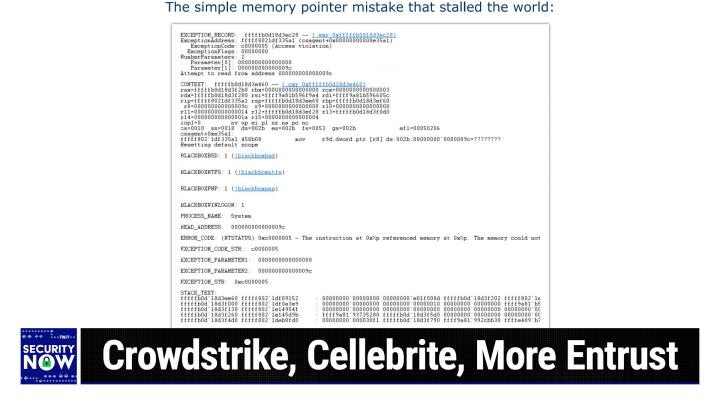Understanding the CrowdStrike Incident
AI created, human edited.
In a recent episode of the acclaimed Security Now podcast, hosts Steve Gibson and Leo Laporte dissected what may be the most significant IT disaster of our time – the CrowdStrike Falcon incident. This catastrophic event, sparked by a single botched update, has sent shockwaves through the global IT landscape and raised critical questions about cybersecurity practices and oversight.
A Digital Doomsday Scenario Unfolds
Picture this: On an otherwise ordinary Friday, a routine update to CrowdStrike's Falcon security software unleashed chaos on an unprecedented scale. In a matter of hours, 8.5 million Windows machines worldwide succumbed to the dreaded blue screen of death (BSOD). The result? A digital apocalypse that grounded planes, halted stock trading, and even disabled emergency services.
As Gibson and Laporte peeled back the layers of this tech catastrophe, they revealed a chilling truth – a simple logic error in a sensor configuration update had brought the digital world to its knees. The fallout was immediate and far-reaching: airports resembled ghost towns, hospitals scrambled to reschedule critical procedures, and ATMs stood silent, their screens dark.
The Culprit: Channel File 291
At the heart of this digital mayhem lay an innocuous file that would soon become infamous in IT circles – channel file 291. Designed to enhance Falcon's endpoint detection and response (EDR) capabilities, this file instead became the epicenter of a global crisis. Even seasoned IT professionals were stumped, forced to manually intervene on each affected machine in a painstaking recovery process.
A Wake-Up Call for the Cybersecurity Industry:
While the CrowdStrike incident dominated the discussion, Gibson and Laporte didn't stop there. They broadened the scope to examine other recent security events, including the FBI's successful unlocking of a smartphone linked to an assassination attempt on former President Trump and a critical vulnerability in Cisco's software. These incidents serve as stark reminders of the ongoing battle between tech companies and malicious actors in our increasingly digital world.
The incident has ignited fierce debates within the tech community. Microsoft is now considering restricting kernel access for security vendors, mirroring Apple's approach. But this potential move raises its own concerns – how can we maintain effective threat detection while limiting system access?
Lessons Learned and the Road Ahead
The CrowdStrike catastrophe serves as a sobering wake-up call for the entire cybersecurity industry. It underscores the critical need for rigorous testing and robust oversight in IT security. As we navigate the aftermath of this digital disaster, one thing is clear – the lessons learned will shape the future of cybersecurity for years to come.
But amidst the chaos and recrimination, it's crucial to remember the vital role that firms like CrowdStrike play in our digital defense. Despite this setback, their track record in detecting and thwarting numerous cyber threats, including those from state-backed hacking groups, remains impressive. The incident highlights the delicate balance we must strike between security and convenience in our increasingly connected world.
Don't Miss Out on the Full Story
Tune in to the latest episode of Security Now to dive deeper into this digital debacle and gain invaluable insights from two of the industry's most respected voices. Gibson and Laporte's comprehensive breakdown of the CrowdStrike incident—along with their analysis of other critical cybersecurity topics—is essential listening for anyone concerned about the future of IT security. Remember, in the ever-evolving world of cybersecurity, knowledge isn't just power – it's your best defense.
Subscribe to Security Now and join Club TWiT for the most trusted tech news available.
